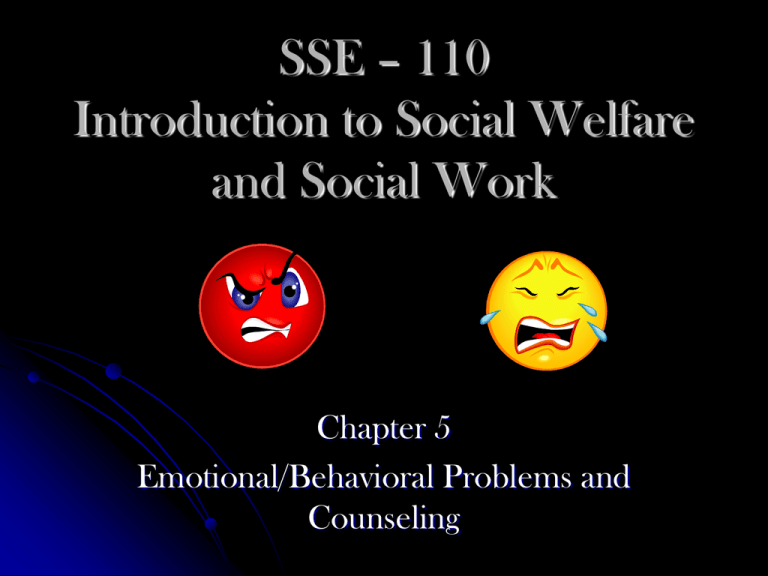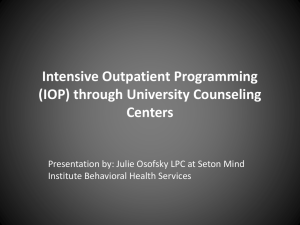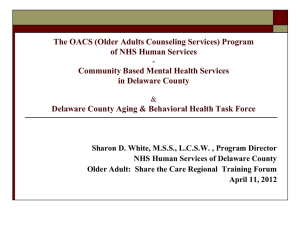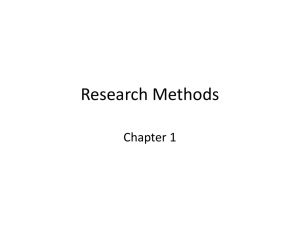
SSE – 110
Introduction to Social Welfare
and Social Work
Chapter 5
Emotional/Behavioral Problems and
Counseling
Emotional/Behavioral Problems and
Counseling
I. A Perspective on Emotional and Behavioral Problems
Read the case scenario on page 140-141.
Everyone, at times, has emotional problems and/or behavioral
difficulties.
II. Nature and Extent of Emotional and Behavioral Problems
One of every four will experience some mental/emotional
problems.
These problems range from depression and anxiety to an eating
disorder to suicide ideation.
Emotional/Behavioral Problems and
Counseling
III. What is Mental Illness?
There are lots of terms to describe unusual behavior (weird,
crazy, insane, uptight, mad, sick, sicko, etc.).
Models 1. Medical 2. Interactional Model
Medical Model
This model views mental and emotional problems to physical
illness.
This model came about to dispel that emotional people are
possessed/demons.
Evidence for this model come from studies – genetics influence
mental/behavioral disorders.
Emotional/Behavioral Problems and
Counseling
See pages 144 – 145 APA Categories of Mental/Emotional
Problems – DSM 1V – TR.
Interactional Model
1950’s – Thomas Szasz felt mental illness was a myth – that is
does not exist.
Focus on process of everyday social interaction and the effects of
labeling.
See page 146 (See Case Example 5.1).
See pages 147 – 150 – How to be Labeled Mentally Ill.
See pages 148 –149 Questioning the Usefulness of the MentalIllness Concept.
Emotional/Behavioral Problems and
Counseling
IV. Labeling as the Cause of Chronic “Mental Illness”
Once labeled does a label stay with a person life long?
Some people believe we need to over haul how we diagnose people
currently.
V. Other Issues
*The homeless – 13% of the homeless may suffer with a mental
illness.
Deinstitutionalization – 1960’s and 70’s.
Homeless veterans
* Civil Rights
Emotional/Behavioral Problems and
Counseling
Involuntary confinement of people (T-36).
*Plea of innocent by reasons of insanity.
Hinckley – tried to assassinate Reagan (1981).
*Use of psychotropic drugs.
Valium – Celexa – Zyprexa.
*Manage health care (HMO).
Reduction of benefits and care to clients with mental and
emotional problems.
See page 162– 172.
Emotional/Behavioral Problems and
Counseling
VI. Social Structure and Mental Illness
Social Class – poor more likely to be labeled mentally ill.
Urbanization – inner has a higher rate of mental illness.
Age – older adults have more mental illness.
Marital status – single have more mental illness.
Also, people divorced and widowed have more mental illness.
Sex – men and women are equally likely to be treated.
Race – African Americans are more likely to be diagnosed as
mentally ill compared to whites.
Combatants in Wars
Emotional/Behavioral Problems and
Counseling
VII. Treatment
Historic treatment of the mentally ill.
First psychiatric hospital was in Williamsburg, VA.
Asylums and total institutions.
Current trends.
Medication
Treatment in community mental health centers.
Therapy / counseling.
Emotional/Behavioral Problems and
Counseling
VIII. Treatment Facilities: Community Mental Health Centers
Community Mental Health Center Act of 1963.
Emphasis on diagnosis and treatment.
Outpatient services.
Partial hospitalization.
Professionals
Today there are only about 100,000 patients in state hospitals
compared to 550,000 in 1955.
Emotional/Behavioral Problems and
Counseling
IX. Social Work and Mental Health
Social worker first worked with the mentally ill in 1906.
Now the emphasis is on treating the family and the patient.
More social workers treating the mentally ill than psychiatrists
and psychologists.
NASW’s role – see page 180.
Emotional/Behavioral Problems and
Counseling
X. Counseling
How to counsel.
Building a relationship.
Exploring a problem in-depth.
Exploring alternative solutions.
Comprehensive and specialized counseling approaches.
*Rational therapy – Albert Ellis.
Read case example 5.3 on pages 170 – 171.








